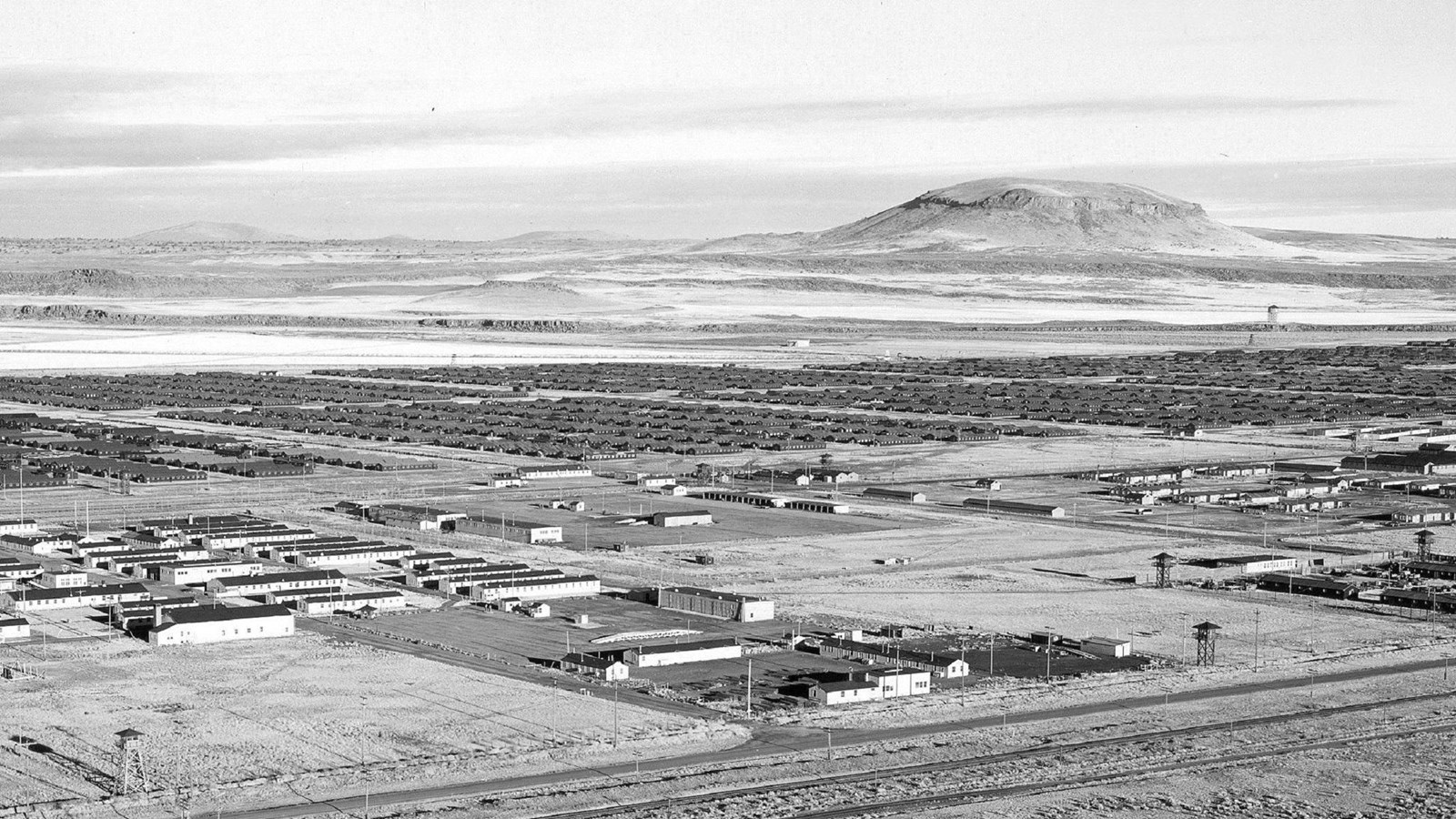Last updated: April 3, 2024
Place
Tule Lake

NPS Photo
Tule Lake was one of the 10 camps operated by the War Relocation Authority (WRA) from May 27, 1942, to March 20, 1946 - the period of Japanese-American incarceration where 110,000 Japanese-Americans were forcibly removed from their homes and communities and incarcerated.
Tule Lake became the largest of the 10 WRA camps, with a peak incarcerated population of 18,789 people, and a total of 29,840 individuals were incarcerated at Tule Lake over the lifetime of the camp’s operation. It comprised 7,400 acres and contained more than 1,700 structures. Nikkei were housed in more than 1,000 barracks, served by latrines, mess halls, and other communal buildings. The camp also contained a post office, a high school, a hospital, a cemetery, factories, railroad sidings, two sewage treatment plants, hog and chicken farms, water wells, and more than 3,500 acres of irrigated farmland. WRA facilities included 144 administration and support buildings. A prison-like atmosphere and lack of freedom was apparent with the 28 guard towers, multiple security fences, a military police compound, and a high security stockade and jail. Tule Lake was also the primary site where 6,000 Japanese Americans renounced their U.S. citizenship.
Tule Lake was the last WRA camp to close, remaining in operation seven months after World War II ended. The administration of the center was returned to the Bureau of Reclamation on May 5, 1946. The dismantling of the segregation center occurred quickly. Barrack buildings were given and sold to new homesteaders in the Tule Lake Basin. In the early 1950s, plots of land within the camp boundary were auctioned by the Bureau of Reclamation to establish the town of Newell.
Tule Lake survivors and their family members were ostracized and stigmatized as being “disloyal” by the general public and within Japanese American communities long after World War II. Deep rifts continue today among individuals and organizations within the Japanese American community due to the loyalty questionnaire. There is strong consensus among scholars that Tule Lake’s history is the “untold story” of the incarceration during World War II
Tule Lake Sites
The Tule Lake Segregation Center area includes the original jail, stockade, and portions of the motor pool and post engineer’s yard. These features retain historic integrity and are essential for conveying the history of Tule Lake. This area is a National Historic Landmark and is owned and managed by the National Park Service.
The Peninsula/Castle Rock was within the boundary of the historic Tule Lake Segregation Center. Originally an island in Tule Lake, it contains an 800-foot bluff called Castle Rock by incarcerees. Atop Castle Rock is a replica of the cross that was placed there by Nikkei incarcerated at Tule Lake before it became a segregation center. The Peninsula is managed primarily for raptor and wildlife habitat. It is located in the Tule Lake National Wildlife Refuge and co-managed by the U.S. Fish and Wildlife Service. It is closed to public access.
Camp Tulelake is a former Civilian Conservation Corps (CCC) camp that was established in the 1930s. During World War II, after the CCC program ended, the camp was used to imprison more than 100 Nikkei from Tule Lake who protested and refused to answer the loyalty questionnaire. It was used again shortly after segregation to house Nikkei strikebreakers brought in from two other WRA camps to harvest the crops. The Tule Lake strikers had demanded better living and working conditions and refused to harvest. Between 1944 and 1946 the camp housed German and Italian prisoners of war who worked as farm laborers in the Tule Lake Basin
Visiting Tule Lake
Begin at the Tule Lake Visitor Center, 8 miles south of the City of Tulelake on Hwy 139. Here, you can learn more about the Segregation Center, watch park videos, speak with a park ranger, and browse the park store. Tours generally begin at the visitor center; please call ahead for more information. Open in summers only.
The former WWII Valor in the Pacific National Monument Tule Lake Unit, now the Tule Lake National Monument, was established to preserve the stories of those forcibly interned during the war and to serve as a reminder to this and future generations of the fragility of American civil liberties. The site is managed by the National Park Service and tours of both Camp Tulelake and the Tule Lake Segregation Center are offered on Saturdays during the summer.
